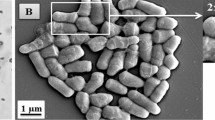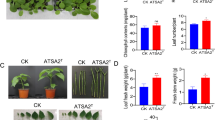Abstract
Twenty-eight endophytic bacteria isolated from stems and leaves of healthy plants in Kanchanaburi Province, Thailand, were characterized and evaluated for their plant growth-promoting activity. Based on their phenotypic characteristics and 16S rRNA gene sequence similarity, the isolates were identified as Pantoea (6 isolates), Priestia (4 isolates), Pseudomonas (3 isolates), Enterobacter (2 isolates), Acinetobacter (2 isolates), Novosphingobium (2 isolates), Curtobacterium (2 isolates), as well as Bacillus, Peribacillus, Sphingobium, Staphylococcus, Brevibacillus, Aneurinibacillus, and Pseudarthrobacter (1 isolate each). Seven isolates produced indole-3-acetic acid (IAA) in nitrogen-free broth supplemented with 0.01% L-tryptophan, eleven isolates fixed nitrogen, and twenty-three isolates solubilized phosphate and zinc. Sphingobium sp. Sx8-8 produced the highest IAA at 67.29 µg mL–1, followed by Novosphingobium sp. SI8-3 and Pantoea sp. S5-1 at 33.06 and 29.4 µg mL–1, respectively. The maximum IAA produced by the Sphingobium sp. Sx8-8 increased to 232.1 µg mL–1 at optimized conditions. In in vitro rice germination, the Sphingobium sp. Sx8-8 and Pantoea sp. S5-1 increased root length, number of lateral roots, and shoot length more than uninoculated control and synthetic IAA as a standard. The genome size of Sphingobium sp. Sx8-8 was 4.67 Mb (83 contigs), N50 size and average G + C content were 150 389 bp and 64.2 mol %, respectively. This study indicated that endophytic bacteria could potentially promote plant growth and be utilized as bioinoculant or biofertilizers in agriculture.




Similar content being viewed by others
REFERENCES
Apine, O.A. and Jadhav, J.P., Optimization of medium for indole-3-acetic acid production using Pantoea agglomerans strain PVM, J. Appl. Microbiol., 2011, vol. 110, pp. 1235−1244.
Alexander, M., Introduction to Soil Microbiology, New York: Wiley, 1997.
Auch, A.F., von Jan, M., Klenk, H.-P., and Göker, M., Digital DNA-DNA hybridization for microbial species delineation by means of genome-to-genome sequence comparison, Stand. Genom. Sci., 2010, vol. 2, pp. 117−134.
Aziz, R.K., Bartels, D., Best, A.A., DeJongh, M., Disz, T, Edwards, R.A., Formsma, K., Gerdes, S., Glass, E.M., Kubal, M., Meyer, F., Olsen, G.J., Olson, R., Osterman, A.L., Overbeek, R.A., et al., The RAST server: rapid annotations using subsystems technology, BMC Genomics., 2008, vol. 9, p. 75.
Bharucha, U. and Patel, K., Optimization of indole acetic acid production by Pseudomonas putida UB1 and its effect as plant growth-promoting rhizobacteria on mustard (Brassica nigra), Agric. Res., 2013, vol. 2, pp. 215−221.
Bhutani, N., Maheshwari, R., Negi, M., and Suneja, P., Optimization of IAA production by endophytic Bacillus spp. from Vigna radiata for their potential use as plant growth promoters, Isr. J. Plant. Sci., 2018, vol. 65, pp. 83−96.
Chesson, P.L. and Warner, R.R., Environmental variability promotes coexistence in lottery competitive-systems, Am. Nat., 1981, vol. 117, pp. 923−943.
Duca, D., Lorv, J., Patten, L.C., Rose, D., and Glick, R.B., Indole-3-acetic acid in plant-microbe interactions, A. van Leeuwenhoek., 2014, vol. 106, pp. 85−125.
Dastager, S.G., Deepa, C.K., Puneet, S.C., Nautiyal, C.S., and Pandey, A., Isolation and characterization of plant growth-promoting strain Pantoea NII-186. from western ghat forest soil, India, Lett. Appl. Microbiol., 2009, vol. 49, pp. 20−25.
Felsenstein, J., Evolutionary trees from DNA sequences: a maximum likelihood approach, J. Mol. Evol. 1981, vol. 17, pp. 68−76.
Felsenstein, J., Confidence limits on phylogenies: an approach using the bootstrap, Evolution, 1985, vol. 39, pp. 783−791.
Flood, J.J. and Copley, D.S., Genome-wide analysis of transcriptional changes and genes that contribute to fitness during degradation of the anthropogenic pollutant pentachlorophenol by Sphingobium chlorophenolicum, mSystems, 2018, vol. 3, pp. 1−16.
Gevers, D., Huys, G., and Swings, J., Applicability of rep-PCR fingerprinting for identification of Lactobacillus species, FEMS Microbiol. Lett.,2001, vol. 205, pp. 31−36.
Giassi, V., Kiritani, C., and Kupper, K.C., Bacteria as growth-promoting agents for citrus rootstocks, Microbiol. Res., 2016, vol. 190, pp. 46−54.
Gomez-Gil, B., Soto-Rodriguez, S., Garcia-Gasca, A., Roque, A., Vazquez-Juarez, R., and Thompson, F.L., Molecular identification of Vibrio harveyi related isolates associated with diseased aquatic organisms, Microbiology, 2004, vol. 150, pp. 1769−1777.
Hansen, H. and Grossmann, K., Auxin-induced ethylene trigger abscisic acid biosynthesis and growth inhibition, Plant Physiol., 2000, vol. 124, pp. 1437−1448.
Hutchinson, G.E., The paradox of the plankton, Am. Nat., 1961, vol. 95, pp. 137−145.
Kalaiselvi, T. and Priya, D., Evaluating the effect of Sphingobium yanoikuyae MH394206 and mixed consortia on growth of rice CO 51 in moisture deficit condition, J. Pharmacogn. Phytochem, 2020, vol. 9, pp. 2016−2021.
Khamwan, S., Boonlue, S., Riddech, N., Jogloy, S., and Mongkolthanaruk, W., Characterization of endophytic bacteria and their response to plant growth promotion in Helianthus tuberosus L., Biocatal. Agric. Biotechnol., 2018, vol. 13, pp. 153−159.
Khanghahi, Y.M., Ricciuti, P., Allegretta, I., Terzano, R., and Crecchio, C., Solubilization of insoluble zinc compounds by zinc solubilizing bacteria (ZSB) and optimization of their growth conditions, ESPR, 2018, vol. 25, pp. 25862−25868.
Kirchhorf, G., Reis, V.M., Baldani, J.I., Eckert, B., Döbereiner, J., and Hartmann, A., Occurrence, physiological and molecular analysis of endophytic diazotrophic bacteria in gramineous energy plants, Plant Soil, 1997, vol. 194, pp. 45−55.
Koichiro, T., Glen, S., and Sudhir, K., MEGA11: Molecular Evolutionary Genetics Analysis Version, Mol. Biol. Evol., 2021, vol. 38, pp. 3022−3027.
Konstantinidis, K.T. and Tiedje, J.M, Towards a genome-based taxonomy for prokaryotes, J. Bacteriol., 2005, vol. 187, no. 18, pp. 6258−6264.
Konstantinidis, K.T. and Tiedje, J.M, Genomic insights that advance the species definition for prokaryotes, Proc. Natl. Acad. Sci. U S A., 2005, vol. 102, no. 7, pp. 2567−2572.
Kukavica, B., Motrović, A., Mojović, M., and Jovanović, S.V., Effect of indole-3-acetic acid on pea root growth, peroxidase profiles and hydroxyl radical formation, Arch. Biol. Sci., 2007, vol. 59, pp. 319−326.
Kumari, S., Prabha, C., Singh, A., Kumari, S., and Kiran, S., Optimization of indole-3acetic-acid production by diazotrophic B. subtilis DR2 (KP455653), isolated from rhizosphere of Eagrostis cynosuroides, Int. J. Pharm. Med., 2018, vol. 7, pp. 20−27.
Luziatelli, F., Gatti, L., Ficca, A.G., Medori, G., Silvestri, C., Melini, F., Muleo, R., and Ruzzi, M., Metabolites secreted by a plant-growth-promoting Pantoea agglomerans strain improved rooting of Pyrus communis L. cv. Dar Gazi cuttings, Front. Microbiol., 2020, vol. 11, pp. 1−11.
Maker, O., Kuźniar, A., Patsula, O., Kavulych, Y., Kozlovskyy, V., Wolińska, A., Skórzyńska-Polit, E., Vatamaniuk, O., Terek, O., and Romanyuk, N., Bacterial endophytes of spring wheat grains and the potential to acquire Fe, Cu, and Zn under their low soil bioavailability, Biology, 2021, vol. 10, pp. 1−24.
Meena, V.S., Maurya, B.R., Verma, J.P., and Meena, R.S., Potassium Solubilizing Microorganisms for Sustainable Agriculture, India, Springer, 2016, pp. 10−25.
Normanly, J., Slovin, J.P., and Cohen, J.D., Rethinking auxin biosynthesis and metabolism, Plant Physiol., 1995, vol. 107, pp. 323−329.
Oliveira, C.A., Alves, V.M.C, Marriel, I.E., Gomes, E.A., Scotti, M.R, Careiro, N.P., Guimarăes, C.T., Schaffert, R.E., and Să, N.M.H., Phosphate solubilizing microorganisms isolated from rhizosphere of maize cultivated in an oxisol of the Brazilian Cerrado Biome, Soil Biol. Biochem., 2009, vol. 41, pp. 1782−1787.
Overbeek, R., Olson, R., Pusch, G.D., Olsen, G.J., Davis J.J., Disz, T., Edwards, R.A., Gerdes, S., Par-rello, B., Shukla, M., Vonstein, V., Wattam, A.R., Xia, F., and Stevens, R., The seed and the rapid annotation of microbial genomes using subsystems technology (RAST), Nucleic Acids Res., 2014, vol. 42, pp. D206−D214.
Patil, N.B., Gajbhiye, M., Ahiwale, S.S., Gunjai, A.B., and Kapadnis, B.P., Optimization of indole 3 acetic acid (IAA) production by Acetobacter diazotrophicus L1 isolated from sugarcane, Int. J. Environ. Sci., 2011, vol. 2, pp. 295−302.
Ramanuj, B.K. and Shelat, N.H., Plant growth promoting potential of bacterial endophytes from medicinal plants. Adv. Res., 2018, vol. 13, pp. 1−15.
Richter, M. and Rossello-Mora, R., Shifting the genomic gold standard for the prokaryotic species definition, Proc. Natl. Acad. Sci. U. S. A., 2009, vol. 106, no. 45, pp. 19126−19131.
Rodrigues, A.A. and Forzani, M.V., Isolation and selection of plant growth-promoting bacteria associated with sugarcane, Pesqui. Agropecu. Trop., 2016, vol. 26, pp. 149−158.
Rodrigues, A.A., Araŭjo, F.V.M., Soares, S.R., Oliveira de F.R.B., Ribeiro, D.A.I., Sibov, T.S., and Vieira, G.J.D., Isolation and prospection of diazotrophic rhizobacteria associated with sugarcane under organic management, An. Acad. Bras. Cienc., 2018, vol. 90, pp. 3813−3829.
Rosenblueth, M. and Martínez-Romero, E., Bacterial endophytes and their interactions with hosts, MPMI, 2006, vol. 19, pp. 827−837.
Saravanan, V.S., Madhaiyan, M., and Thangaraju, M., Solubilization of zinc compounds by the diazothrophic, plant growth promoting bacterium Gluconacetobacter diazotrophicus, Chemosphere, 2007, vol. 66, pp. 1794−1798.
Shaik, I., Janakiram, P., Sujatha, L., and Chandra, S., Isolation and identification of IAA producing endosymbiotic bacteria from Gracilaria corticata (J. Agardh), Int. J. Bioassays, 2016, vol. 5, pp. 5179−5184.
Sierra, G., A simple method for the detection of lipolytic activity of micro-organisms and some observation on the influence of the contact between cells and fatty substance, A. van Leeuwenhoek, 1957, vol. 23, p. 15.
Song, C., Wang, W., Gan, Y., Wang, L., Chang, X., Wang, Y., and Yang, W., Growth promotion ability of phosphate-solubilizing bacteria from the soybean rhizosphere under maize soybean intercropping systems, J. Sci. Food Agric., 2022, vol. 102, pp. 1430−1442.
Spaepen, S., Vanderleyden, J., and Remans, R., Indole-3-acetic acid in microbial and microorganism-plant signaling, FEMS Microbiol. Rev., 2007, vol. 31, pp. 425−448.
Stackebrand, E. and Ebers, J., Taxonomic parameters revisited: tarnished gold standards, Microbiol. Today., 2006, vol. 33, pp. 152−155.
Svehla, G., Vogel’s Textbook of Macro and Semimicro Qualitative Inorganic Analysis, London: Longman, 1979.
Tanasupawat, S., Okada, S., and Komagata, K., Lactic acid bacteria found in fermented fish in Thailand, J. Gen. Appl. Microbiol., 1998, vol. 44, pp. 193−200.
Tolieng, V., Booncharoen, A., Nuhwa, R., Thongchul, N., and Tanasupawat, S., Molecular identification, L-lactic acid production, and antibacterial activity of Bacillus strains isolated from soils, J. Appl. Pharm. Sci., 2018, vol. 8, pp. 98−105.
Varghese, N.J., Mukherjee, S., Ivanova, N., Konstantinidis, K.T., Mavrommatis, K., Kyrpides, N.C., and Pati, A., Microbial species delineation using whole genome sequences, Nucleic Acids Res., 2015, vol. 43, pp. 6761−6771.
Versalovic, J., Schneider, M., de Bruijn, F.J., and Lupski, J.R., Genomic fingerprinting of bacteria using repetitive sequence-based polymerase chain reaction, Methods Mol. Cell BioI., 1994, vol. 5, pp. 25−40.
Wei, Y.D., Zheng, H., and Hall, J.C., Role of auxinic herbicide-induced ethylene on hypocotyl elongation and root/hypocotyl radial expansion, Pest Manag. Sci., 2000, vol. 56, pp. 377−387.
Welch, M.R. and Graham, D.R., Breeding for micronutrients in staple food crops from a human nutrition perspective, J. Exp. Bot., 2004, vol. 55, pp. 353−364.
Yoon, S.H., Ha, S.M., Kwon, S., Lim, J., Kim, Y., Seo, H., and Chun, J., Introducing EzBioCloud: a taxonomically united database of 16S rRNA gene sequences and whole-genome assemblies, Int. J. Syst. Evol. Microbiol., 2017, vol. 67, no. 5, p. 1613.
Yu, J., Yu., H., Fan, G.Q., Wang, G.H., and Liu, X.B., Isolation and characterization of indole acetic acid producing root endophytic bacteria and their potential for promoting crop growth, J. Agric. Sci. Technol., 2016, vol. 18, pp. 1381−1391.
Zhang, T., Hu, F., and Ma, L., Phosphate-solubilizing bacteria from safflower rhizosphere and their effect on seedling growth, Open Life Sci., 2019, vol. 14, pp. 246−254.
ACKNOWLEDGMENTS
This work was supported by the 90th Anniversary of Chulalongkorn University Fund (Ratchadaphiseksomphot Endowment Fund), Graduate School, Chulalongkorn University. We thank the Program in Biotechnology, Faculty of Science, Chulalongkorn University and Faculty of Science and Technology, Suan Sunandha Rajabhat University for providing research facilities.
Author information
Authors and Affiliations
Corresponding author
Ethics declarations
The authors declare that they have no conflict of interest. This article does not contain any studies involving animals or human participants performed by any of the authors.
Rights and permissions
About this article
Cite this article
Sitlaothaworn, K., Budsabun, T., Booncharoen, A. et al. Diversity of Plant Growth-Promoting Endophytic Bacteria, Genome Analysis of Strain Sx8-8 and Its Rice Germination Promoting Activity. Microbiology 92, 269–283 (2023). https://doi.org/10.1134/S002626172260183X
Received:
Revised:
Accepted:
Published:
Issue Date:
DOI: https://doi.org/10.1134/S002626172260183X




